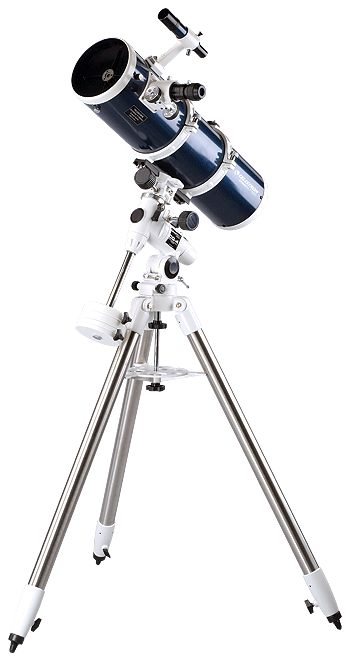Celestron Super Polaris C6 (SPC6) and Omni XLT 150 Telescopes By Chuck Hawks with Jim Fleck The SPC6 was Celestron's finest Newtonian reflector in 1985. Celestron claimed that it performed better optically than any other telescope of its aperture size. It was so successful that a modern descendent, the Omni XLT 150, is still in the line and still popular. Not only is the Omni XLT 150 telescope identical to the C6 in both clear aperture (150mm), focal length (750mm) and performance, Celestron's excellent CG-4 German Equatorial mount is the lineal descendent of the Super Polaris German Equatorial mount upon which the SPC6 rode. Obviously 6", short focal length Newtonian reflectors have staying power in the marketplace. Let's look at the reasons. The biggest is light grasp. That 5.91" (150mm) clear aperture collects 459 times as much light as the unaided human eye (based on a 7mm pupil diameter). That kind of light grasp is ideal for viewing otherwise invisible deep space objects, such as nebulae and galaxies. Every object in the Messier list can be seen by a C6 or XLT 150. The short 750mm focal length makes for a wide field of view, as well as a "fast" focal ratio of f/5. In other words, these are bright telescopes. The robust Super Polaris German equatorial mount featured setting circles, precise manual slow motion controls, motion paddle locks, a Polaris finder scope with illumination and a wooden surveyor's type tripod. An optional dual axis, sidereal rate, 12 VDC motor drive set with hand controller was available. The latest version of this mount, the CG-4, has been improved. It now features ball bearing races on both axis and a heavier tripod with 1.75" stainless steel legs. The Polaris alignment scope CG-4 and dual axis motor drive set DA are available as accessories from Celestron. Both telescopes came with a parabolic primary mirror and a Plossl ocular that delivered 29-30x magnification. While very similar, the C6 and Omni XLT 150 are not identical. For one thing, the C6 was gloss black with the word "Celestron" stenciled in orange on each side, while the Omni is finished in a pearl navy blue with white front and rear cells. A more important difference is the focusers. The C6 used a slide focus system that moved the secondary mirror and focuser up and down in relation to the primary mirror. The secondary mirror was supported by a single wide, but narrow, aluminum arm. This design reduced the size of the secondary obstruction and focusing the scope automatically compensated for changes in the length of the seamless aluminum main tube due to temperature variations, a concern with most Newtonian reflectors. The Omni XLT 150 uses a conventional spider to support the secondary mirror and a rack and pinion focuser. The XLT 150 mirrors receive Celestron's proprietary Starbright XLT coatings, while the SPC6 mirrors were multi-coated. Here are the basic specifications of both telescopes. (C6 in parenthesis where different.)  Celestron Omni XLT 150. Illustration courtesy of Celestron International.
My first "serious" telescope was an SPC6, so I feel qualified to comment on the breed. My good friend Jim Fleck and I pooled our resources to buy an SPC6 that neither of us could readily afford on his own. The SPC6 taught us the benefits of a German equatorial mount and how to use one. It also taught us the benefits of Newtonian reflectors (light grasp, reasonable price) and their drawbacks (frailty and susceptibility to the intrusion of dust and dirt), although compared to most, the C6 was a robust Newtonian. We also appreciated the slide focus system, which eliminated much of the need to regularly collimate the scope. It was also about as heavy as an 8" SCT on a German equatorial mount and just as time consuming to set up. That is why we eventually traded it for a Celestron SPC8. (Similar to today's C8SGT without the go-to feature.) However, we have never forgotten the bright, wide sky views from our 6" Newt. It was a spectacular performer on large deep sky subjects, such as the Double Cluster, Andromeda Galaxy and Pleiades. With an O-III filter, large diffuse nebulas like the Veil and North American are relatively easy. As reasonably portable and reasonably economical deep sky scopes go, it was--and is--a standout. The SPC6 and XLT 150 lack the focal length (and perhaps contrast) to be top performers on planetary subjects, but with short focal length oculars they will do the job, providing appealing views of both planets and the moon. When we owned the SPC6, our short focal length (high magnification) oculars were Orthos or Plossls, so eye relief and apparent field of view were definitely restricted, making high magnification viewing less than ideal. Today, Tele Vue Nagler 6, Tele Vue Radian, Burgess/TMB Planetary, Celestron X-Cel and Celestron Ultima oculars are just what the doctor ordered for an SPC6 or an Omni XLT 150. Such long eye relief, wide field oculars give short focal length telescopes practical, high magnification capability only dreamed of 20 years ago. These are relatively expensive eyepieces, but they would be a very good investment for the owner of a C6 or XLT 150 telescope. The Super Polaris mount was a good match for the SPC6 and today's CG-4, supplied with the Omni XLT 150, is markedly improved. The CG-4 is stouter and dampens vibration very quickly. Anyone who is looking for a lot of deep sky capability on an excellent mount at a reasonable price need look no farther than a Celestron Omni XLT 150. |